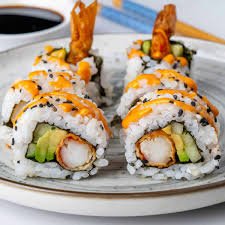Shrimp Tempura is a dish that has captured the hearts and taste buds of many people around the world. With its crispy golden coating and tender shrimp inside, it’s no wonder that this Japanese delicacy has become a favorite in restaurants and homes alike. Whether you’re dining at a high-end sushi restaurant or enjoying a homemade meal, shrimp tempura is always a crowd-pleaser.
But what exactly is shrimp tempura? Why has it become such a beloved dish, and how can you make it at home? Let’s take a closer look at this crispy, crunchy, and delicious seafood treat that has taken the culinary world by storm.

The Origins of Shrimp Tempura
Tempura, including shrimp tempura, is a Japanese dish that is believed to have been introduced to Japan by Portuguese missionaries and traders in the 16th century. The word “tempura” comes from the Latin word “temporada,” which refers to periods of fasting when Catholics were allowed to eat fish instead of meat. The dish was brought to Japan by Portuguese missionaries who were teaching Christianity.
Tempura, however, is more than just shrimp. It refers to battered and deep-fried seafood or vegetables. The technique of deep frying food in a light batter was quickly embraced by the Japanese, and it evolved into a unique and beloved culinary art form.
Shrimp tempura, as we know it today, became popular in the Edo period (1603–1868), and since then, it has remained one of Japan’s most famous dishes. Today, shrimp tempura can be found in sushi restaurants, street food stalls, and even in home kitchens.
What Makes Shrimp Tempura So Special?
The magic of shrimp tempura lies in its simplicity and texture. The shrimp itself is sweet and tender, while the batter is light, crispy, and slightly airy. It’s the perfect combination of crunchy and soft. When done right, shrimp tempura should not feel greasy or heavy. Instead, it should be a crispy delight that pairs perfectly with a dipping sauce.
A well-made shrimp tempura should also have a delicate balance in flavor. The shrimp should be fresh, with a sweet taste that comes through the batter. The batter itself is usually made from a mixture of flour, cornstarch, and ice-cold water. This cold batter helps create a light and crispy texture when fried. Some recipes may also use egg yolks to give the batter a little more richness, but the key is to keep the batter as light as possible to let the shrimp shine.
How Is Shrimp Tempura Made?
Making shrimp tempura at home might sound complicated, but with a few simple steps, anyone can master it. Here’s a basic recipe for making shrimp tempura:
Ingredients:
- 12 large shrimp (peeled and deveined)
- 1 cup all-purpose flour
- 1/4 cup cornstarch
- 1 egg (optional for extra richness)
- 1 cup cold water (or ice water for a lighter texture)
- Salt (to taste)
- Pepper (to taste)
- Vegetable oil (for frying)
- Tempura dipping sauce (optional)
Instructions:
- Prepare the Shrimp: Start by peeling the shrimp and removing the shells. If you like, you can leave the tails on for extra presentation. Once peeled, make a shallow incision along the back of the shrimp and remove the vein. This will help the shrimp cook more evenly.
- Make the Batter: In a bowl, whisk together the flour, cornstarch, and a pinch of salt and pepper. In another bowl, lightly beat the egg, if using. Slowly add the cold water to the flour mixture, stirring gently until the batter forms. It’s okay if the batter is a little lumpy—this will help create the crispy texture when fried. If you’re using ice water, the batter will be even lighter and crisper.
- Heat the Oil: Heat a pot or deep fryer with vegetable oil to 350°F (175°C). You want enough oil to submerge the shrimp completely.
- Dip the Shrimp: Once the oil is hot, dip the shrimp into the batter, coating them lightly. Hold the shrimp by the tail and gently drop them into the hot oil. Be careful not to overcrowd the pot; fry the shrimp in batches if necessary.
- Fry the Shrimp: Fry the shrimp for about 2-3 minutes, or until they are golden brown and crispy. You may need to adjust the frying time depending on the size of the shrimp.
- Drain and Serve: Use a slotted spoon to remove the shrimp from the oil and drain them on a paper towel-lined plate. Serve immediately with a side of tempura dipping sauce, or enjoy them as they are.
The Best Way to Enjoy Shrimp Tempura
Shrimp tempura is often served with a dipping sauce, which is typically made from a mixture of soy sauce, mirin (a sweet rice wine), and dashi (a Japanese stock). This sauce complements the light and crispy batter and enhances the natural sweetness of the shrimp. The dipping sauce adds a savory umami flavor that balances out the richness of the fried shrimp.
In Japan, shrimp tempura is commonly enjoyed as part of a larger meal, often with rice, miso soup, or noodles. Tempura can also be served as an appetizer or snack at various Japanese restaurants. In some places, tempura is even served in sushi rolls, where it is wrapped in seaweed and served with rice.
Why Shrimp Tempura Is a Favorite Dish
One reason why shrimp tempura is so popular is that it combines simple ingredients that create a memorable meal. The light batter doesn’t overwhelm the flavor of the shrimp, and the crispy exterior contrasts wonderfully with the tender inside. It’s a dish that’s perfect for both seafood lovers and those who may not typically enjoy fish, as the light batter and frying process make it more approachable.
Shrimp tempura is also versatile. You can enjoy it as a main dish, appetizer, or part of a larger Japanese meal. Its mild flavor pairs well with many different sides, from fresh salads to savory miso soup.
Another reason shrimp tempura is beloved is that it’s relatively easy to prepare. Although it may seem like an advanced dish to make, once you get the hang of frying, the process is quick and simple. Plus, there’s nothing quite like the satisfaction of biting into a piece of crispy, perfectly cooked shrimp that you’ve made yourself.
Tips for Perfect Shrimp Tempura
If you want to take your shrimp tempura to the next level, here are a few tips to keep in mind:
- Use fresh shrimp: Fresh shrimp will give you the best flavor and texture. Make sure the shrimp you’re using are properly deveined and peeled before frying.
- Keep the batter cold: The colder the batter, the crispier the tempura will be. Use ice-cold water or even ice cubes in your batter.
- Don’t overcrowd the pot: Fry the shrimp in small batches to ensure that they cook evenly and stay crispy. Overcrowding the oil can cause the shrimp to become soggy.
- Serve immediately: Tempura is best when it’s freshly fried, so try to serve it right after cooking.
Conclusion
Shrimp tempura is more than just a dish—it’s a crispy, golden bite of joy that has become a staple in Japanese cuisine and a favorite worldwide. Whether you’re enjoying it at a restaurant or making it at home, shrimp tempura is a treat that never fails to impress. With its light batter, tender shrimp, and irresistible crunch, shrimp tempura is the ultimate comfort food that’s sure to satisfy your cravings.
Lemon Ricotta Pancakes – A Flavorful Twist on Your Morning Routine





